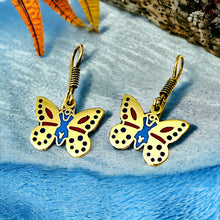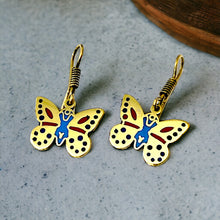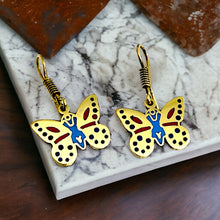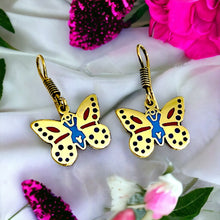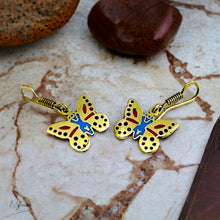
Exquisite Gold Egyptian Butterfly Earring: Inspired by the timeless elegance of ancient Egypt, this delicate yet striking piece combines the symbolism of the butterfly with the opulence of gold. A perfect gift for women, symbolizing beauty, transformation, and the enduring allure of Egyptian culture.
- History: Inspired by ancient Egyptian jewelry aesthetics.
- Spiritually: Represents transformation and rebirth, mirroring the metamorphosis of a butterfly.
- Talisman: Thought to bring luck, protection, and positive energy to the wearer.
- Handmade: Crafted meticulously with attention to detail, ensuring uniqueness in each piece.
- Healing: Believed to promote emotional healing and spiritual growth.
- Material Gold: Made of high-quality gold, symbolizing wealth, prosperity, and purity.
- Symbolism: Butterfly signifies change, endurance, and beauty in various cultures.
- How to Wear: Can be worn as a statement piece for formal occasions or as a daily accessory.
- Gold Egyptian Butterfly Earring: Combines ancient Egyptian motifs with the delicate beauty of a butterfly.
- Gift for Women: A meaningful present symbolizing transformation, strength, and beauty.
History Side For Those Who Are Interested
"The Egyptian Butterfly" is a term used to describe a significant historical event in the realm of Egyptology. This event refers to the discovery of the tomb of Tutankhamun, also known as King Tut, in the Valley of the Kings near Luxor, Egypt, in 1922 by British archaeologist Howard Carter. The term "butterfly" metaphorically represents the emergence of this monumental find, akin to a butterfly emerging from its cocoon, transforming the understanding of ancient Egyptian history and culture.
Tutankhamun was a relatively minor pharaoh of the 18th dynasty who ascended to the throne at a young age, around 1332 BC, during the New Kingdom period of ancient Egypt. His reign was short, lasting only around nine years, and his tomb, unlike those of some of his more illustrious predecessors, was relatively modest in size and construction. However, what it lacked in grandeur, it compensated for in its remarkable preservation and the wealth of artifacts it contained.
The discovery of Tutankhamun's tomb was the culmination of years of meticulous excavation and exploration by Howard Carter and his team, funded by Lord Carnarvon. After years of fruitless searching, Carter's persistence paid off when, on November 4, 1922, his workers stumbled upon a step carved into the rock, which led to the sealed entrance of the tomb.
As they carefully excavated the tomb's chambers, they uncovered a treasure trove of artifacts, including the famous golden death mask, jewelry, chariots, weapons, clothing, and furniture, among other items. The discovery sparked global fascination and renewed interest in ancient Egypt, captivating the public's imagination and leading to what is often referred to as "Tutmania."
The Egyptian Butterfly, as this event came to be symbolically known, had far-reaching implications. It provided unprecedented insights into the funerary practices, artisanship, and daily life of ancient Egyptians. The meticulous documentation and preservation of the tomb and its contents set new standards for archaeological practice and laid the groundwork for modern Egyptology.
Moreover, the discovery of Tutankhamun's tomb had a profound impact on popular culture, inspiring countless books, films, and exhibitions. It also fueled ongoing debates and research into the life, reign, and familial relations of Tutankhamun, including theories surrounding his parentage, cause of death, and the political and religious upheavals of his time.
In summary, the Egyptian Butterfly represents not only the discovery of Tutankhamun's tomb but also the transformative impact it had on the study of ancient Egypt, archaeology, and our understanding of human history. It stands as a testament to the enduring allure and mystery of ancient civilizations and the power of archaeological exploration to illuminate the past.









